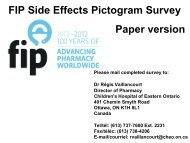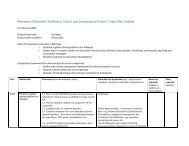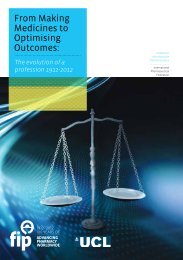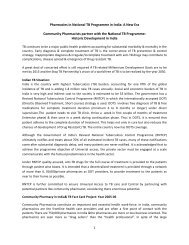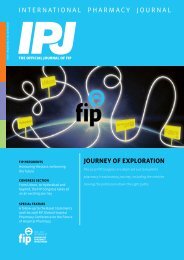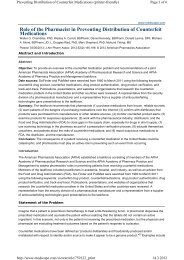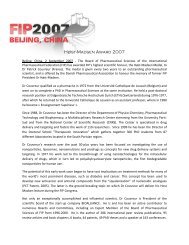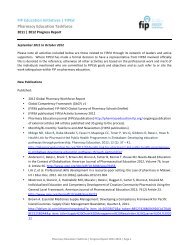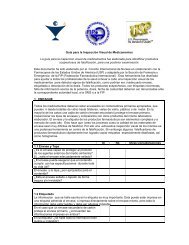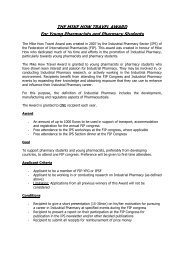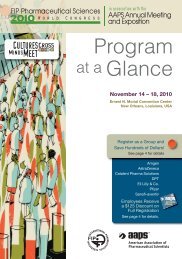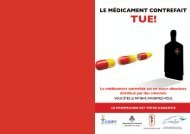Metronidazole - FIP
Metronidazole - FIP
Metronidazole - FIP
You also want an ePaper? Increase the reach of your titles
YUMPU automatically turns print PDFs into web optimized ePapers that Google loves.
COMMENTARIES<br />
Biowaiver Monographs for Immediate Release Solid Oral Dosage<br />
Forms: <strong>Metronidazole</strong><br />
CAMILA F. REDIGUIERI, 1 VALENTINA PORTA, 2 DIANA S. G. NUNES, 1 TAINA M. NUNES, 1 HANS E. JUNGINGER, 3<br />
SABINE KOPP, 4 KAMAL K. MIDHA, 5 VINOD P. SHAH, 6 SALOMON STAVCHANSKY, 7 JENNIFER B. DRESSMAN, 8<br />
DIRK M. BARENDS9 1Brazilian Health Surveillance Agency (Anvisa), Division of Bioequivalence, Brasilia, Brazil<br />
2Faculty of Pharmaceutical Sciences, University of Sao Paulo, Brazil<br />
3Faculty of Pharmaceutical Sciences, Naresuan University, Phitsanulok, Thailand<br />
4World Health Organization, Geneva, Switzerland<br />
5University of Saskatchewan, Saskatoon, Saskatchewan, Canada<br />
6International Pharmaceutical Federation (<strong>FIP</strong>), The Hague, the Netherlands<br />
7College of Pharmacy, Pharmaceutics Division, University of Texas in Austin, Austin, Texas, 78712<br />
8Institute of Pharmaceutical Technology, Goethe University, Frankfurt am Main, Germany<br />
9RIVM—National Institute for Public Health and the Environment, Bilthoven, the Netherlands<br />
Received 7 July 2010; revised 25 October 2010; accepted 26 October 2010<br />
Published online 19 January 2011 in Wiley Online Library (wileyonlinelibrary.com). DOI 10.1002/jps.22409<br />
ABSTRACT: Literature data relevant to the decision to allow a waiver of in vivo bioequivalence<br />
(BE) testing for the approval of immediate release (IR) solid oral dosage forms containing<br />
metronidazole are reviewed. <strong>Metronidazole</strong> can be assigned to Biopharmaceutics Classification<br />
System Class I. Most BE studies that were identified reported the investigated formulations<br />
to be bioequivalent, indicating the risk of bioinequivalence to be low. Formulations<br />
showing differences in bioavailability showed dissimilarities in in vitro dissolution profiles.<br />
Furthermore, metronidazole has a wide therapeutic index. It is concluded that a biowaiver<br />
for solid IR formulations is justified, provided: (a) the test product and its comparator are<br />
both rapidly dissolving; (b) meet similarity of the dissolution profiles at pH 1.2, 4.5, and 6.8;<br />
(c) the test product contains only excipients present in IR drug products approved in International<br />
Conference on Harmonisation (ICH) or associated countries in the same dosage form;<br />
and (d) if the test product contains sorbitol, sodium laurilsulfate, or propylene glycol. The<br />
test product needs to be qualitatively and quantitatively identical to its comparator with respect<br />
to these excipients. © 2011 Wiley-Liss, Inc. and the American Pharmacists Association J<br />
Pharm Sci 100:1618–1627, 2011<br />
Keywords: dissolution; absorption; Biopharmaceutics Classification System (BCS); metronidazole;<br />
permeability; regulatory science; solubility<br />
Correspondence to: D.M. Barends (Telephone: +31-30-274-4209;<br />
Fax: +31-30-274-4462; E-mail: dirk.barends@rivm.nl)<br />
A project of the International Pharmaceutical Federation <strong>FIP</strong>,<br />
Special Interest Group BCS & Biowaiver, www.fip.org/bcs. This article<br />
reflects the scientific opinion of the authors and not necessarily<br />
the policies of regulating agencies, the International Pharmaceutical<br />
Federation (<strong>FIP</strong>) and the World Health Organization (WHO),<br />
nor the Brazilian Health Surveillance Agency (Anvisa).<br />
Journal of Pharmaceutical Sciences, Vol. 100, 1618–1627 (2011)<br />
© 2011 Wiley-Liss, Inc. and the American Pharmacists Association<br />
1618 JOURNAL OF PHARMACEUTICAL SCIENCES, VOL. 100, NO. 5, MAY 2011<br />
INTRODUCTION<br />
A monograph based on literature data is presented<br />
on metronidazole, with respect to its biopharmaceutical<br />
properties and the risk of waiving in vivo<br />
bioequivalence (BE) testing for the approval of new<br />
immediate release (IR) solid oral dosage forms containing<br />
metronidazole, including both reformulated<br />
products and new multisource products. The purpose<br />
and scope of this series of monographs were discussed
previously. 1 Briefly, the aim is to evaluate all pertinent<br />
data available from literature sources to assess<br />
the risk of a biowaiver decision and recommend<br />
whether a biowaiver is advisable or not. Risks considered<br />
are both the chance of an incorrect biowaiver<br />
decision and the assessment of its consequences on<br />
public health and individual patient risks. This systematic<br />
approach to recommend or to advise against<br />
a biowaiver decision is referred to in the recently published<br />
World Health Organization (WHO) Guideline. 2<br />
These monographs do not intend to simply apply<br />
the WHO, 2 United States Food and Drug Administration<br />
(FDA), 3 and/or European Medicines Agency<br />
(EMA) Guidance, 4 but aim also as a critical evaluation<br />
of these and other countries’ regulatory documents.<br />
Biowaiver monographs have already been published<br />
for several active pharmaceutical ingredients (APIs),<br />
also available online at www.fip.org/bcs. 5<br />
EXPERIMENTAL<br />
Literature data were obtained from Web of Science,<br />
PubMed, and Micromedex databases up to December<br />
12, 2009. The keywords used for searching were<br />
as follows: metronidazole, intestine absorption, linear<br />
absorption, absolute bioavailability, human bioavailability,<br />
bioequivalence, log P, solubility, permeability,<br />
and lipophilicity.<br />
GENERAL CHARACTERISTICS<br />
Name<br />
INN: <strong>Metronidazole</strong>. 6,7 Its structure is shown in<br />
Figure 1.<br />
Therapeutic Indications and Dose<br />
<strong>Metronidazole</strong> is classified in the WHO Essential<br />
Medicines List as antiamoebic, antigiardiasis, and<br />
antibacterial. 8 It is used in combination with other<br />
antibiotics and either bismuth compounds or proton<br />
pump inhibitors for treatment of peptic ulcer disease<br />
caused by Helicobacter pylori. 9–12 Because of its activity<br />
against anaerobic bacteria, metronidazole has<br />
also been employed in the treatment of periodontal<br />
disease. 13,14 Approved indications include treatment<br />
of trichomoniasis, vaginitis, and urethritis caused<br />
Figure 1. Structure of metronidazole; molecular weight:<br />
171.16.<br />
BIOWAIVER MONOGRAPH FOR METRONIDAZOLE 1619<br />
by Gardnerella vaginalis, giardiasis, amoebiasis, and<br />
infections caused by anaerobic bacteria, 15 which comprise<br />
intraabdominal infections, skin and skin structure<br />
infections, gynecologic infections, bacterial septicemia,<br />
bone and joint infections, central nervous<br />
system infections, lower respiratory tract infections,<br />
and endocarditis. 16 Depending on the indication, the<br />
dosage regimen can vary from 250 mg three times<br />
daily for 7 days to 750 mg three times daily for<br />
10 days. Single doses of 2 g can also be used. 16 Daily<br />
doses can be as high as 2.5 g. 9<br />
Therapeutic Index and Toxicity<br />
<strong>Metronidazole</strong> is, in general, very well tolerated,<br />
has a wide therapeutic index, 10 and its serum<br />
and tissue concentrations do not require routine<br />
determination. 17 The most common adverse reactions<br />
reported occur in the gastrointestinal (GI) tract,<br />
particularly nausea, anorexia, diarrhea, epigastric<br />
distress, constipation, and abdominal cramps. 9,18,19<br />
Less frequent untoward effects in the digestive<br />
tract include an unpleasant metallic taste and<br />
vomiting. 9,18,19 Occasionally, dysuria, cystitis, dry<br />
mouth, dry vulva and vagina, feeling of pelvic pressure,<br />
vaginal burning, rash, headache, and insomnia<br />
may occur. 18,19 Incoordination, dizziness, vertigo,<br />
encephalopathy, convulsion, and ataxia are rare<br />
neurotoxic effects that warrant discontinuation of<br />
metronidazole. 9,18,19 Temporary neutropenia may occur,<br />
and raised liver enzyme values, cholestatic hepatitis,<br />
and jaundice have occasionally been reported. 9<br />
CHEMICAL PROPERTIES<br />
Salt, Esters, and Polymorphs<br />
The British Pharmacopoeia, the European Pharmacopoeia,<br />
the International Pharmacopoeia, and the<br />
US Pharmacopoeia have monographs for metronidazole<br />
base and metronidazole benzoate20–23 ; the Brazilian<br />
Pharmacopoeia has a monograph for metronidazole<br />
base only. 24 <strong>Metronidazole</strong> base is used<br />
for gel, injections, tablets, and suppositories, 20–24<br />
whereas metronidazole benzoate is formulated as oral<br />
suspensions. 20 <strong>Metronidazole</strong> hydrochloride is used<br />
for injections. 9 This monograph refers to metronidazole<br />
base only. Polymorphism has not been reported<br />
for the metronidazole base.<br />
Solubility<br />
<strong>Metronidazole</strong>’s solubility in water was reported as<br />
10 mg/mL at 20 ◦ C 25 and 10.5 mg/mL at 25 ◦ C. 26 Another<br />
source reported a solubility of 64.8 mg/mL at<br />
room temperature and pH 1.2, decreasing to around<br />
10 mg/mL at pH values between 2.5 and 8.0. 27,28<br />
Lindenberg et al. 29 conducted solubility experiments<br />
at 37 ◦ C in buffers at pH 1.2, 4.5, and 6.8; the values<br />
DOI 10.1002/jps JOURNAL OF PHARMACEUTICAL SCIENCES, VOL. 100, NO. 5, MAY 2011
1620 REDIGUIERI ET AL.<br />
Table 1. Solubility at 37 ◦ C of <strong>Metronidazole</strong> from Literature Data 30 and the Corresponding Dose/Solubility (D/S)<br />
Ratio’s for Different Definitions of D<br />
D/S a (mL)<br />
pH Medium Solubility at 37 ◦ C (mg/mL) 500 (mg) b 2000 (mg) c<br />
1.0 Clark–Lubs buffer 30.6 16 65<br />
3.0 McIlvaine buffer 14.1 35 142<br />
5.0 McIlvaine buffer 12.8 39 156<br />
7.0 McIlvaine buffer 11.6 43 172<br />
a Critical limit: 250 mL.<br />
b Highest strength of IR solid oral dosage forms on US market and also highest tablet strength of WHO List of Essential Medicines.<br />
c Highest single dose administered.<br />
were not reported, but metronidazole was concluded<br />
to be highly soluble at a dose of 500 mg. Table 1 shows<br />
the data reported by Ogata et al. 30 at 37 ◦ C in the pH<br />
range 1.0–7.0, being the most relevant for Biopharmaceutics<br />
Classification System (BCS).<br />
Partition Coefficient<br />
At 25◦C, log P values of 0.7526 and −0.0231,32 were<br />
reported in n-octanol/water and in n-octanol/0.1 M<br />
sodium diphosphate buffer (pH 7.4), respectively.<br />
A log D value of −0.27 at pH 5.0 has also been<br />
reported. 31<br />
pKa<br />
<strong>Metronidazole</strong> is a basic compound with pKa value of<br />
2.62. 18,27<br />
Available Dosage Forms Strengths<br />
The WHO Essential Medicines List includes metronidazole<br />
IR tablets with strengths ranging from 200 to<br />
500 mg. 8 Tablets of higher strengths are not known<br />
to be marketed (see Table 2).<br />
PHARMACOKINETIC PROPERTIES<br />
Absorption and Bioavailability<br />
Recognized textbooks and reviews report metronidazole<br />
to be rapidly absorbed with a bioavailability<br />
(BA) of higher than 90% and approaching toward<br />
100%. 9,17,19,33 Pharmacokinetic studies reported in<br />
the literature support the presence of high BA. In<br />
a study with eight healthy male volunteers receiving<br />
metronidazole orally as a 400-mg tablet and intravenously<br />
(i.v.), the fraction absorbed was reported<br />
to be higher than 0.98. 34 Another study consisted of<br />
four separate experiments in which metronidazole<br />
and tinidazole were compared after i.v. and oral administration.<br />
Five volunteers took part in the study,<br />
and the BA of the 500 mg metronidazole tablets was<br />
reported to be 111%. 35 <strong>Metronidazole</strong> pharmacokinetics<br />
was also studied in five healthy women after single<br />
oral dose versus i.v.; the mean oral BA was reported<br />
as 100 ± 5%. 36 In another study, the pharmacokinetics<br />
of metronidazole was measured in eight con-<br />
senting patients. Single doses of 0.5, 1, 1.5, and 2 g<br />
were administered i.v. by a zero-order infusion pump;<br />
seven of the eight patients received a second, identical,<br />
oral dose 1 week later, and the oral BA of metronidazole<br />
was calculated to be approximate 100%. 37<br />
Only one study of metronidazole tablets was identified<br />
reporting a BA below the critical limit of 85%; in<br />
that crossover study in 11 volunteers, 400 mg tablets<br />
from two manufacturers were compared against an<br />
800 mg i.v. dose. Both unchanged metronidazole<br />
and its hydroxy metabolite were measured by highperformance<br />
liquid chromatography. The BA of the<br />
two tablet brands was reported to be 80.4% and 84.1%,<br />
respectively. 38<br />
Oral doses of 250, 500, 750, and 2000 mg gave maximum<br />
plasma concentrations (Cmax) of 6, 12, 20, and<br />
40 :g/mL, 9,16,39–41 with time to Cmax (tmax) ranging<br />
from 0.25 to 4 h. 16,19,33–36,39–41 Pharmacokinetics is<br />
linear up to a dose of 2000 mg. 19 Administration with<br />
food may delay, but does not reduce the absorption of<br />
metronidazole. 9 In a study in which the BE of a formulation<br />
containing metronidazole, bismuth biscalcitrate,<br />
and tetracycline combined in one capsule was<br />
evaluated in fed and fasting conditions, and was also<br />
compared with the same drugs administered in separate<br />
capsules in fasted conditions, it was concluded<br />
that food slightly decreases the rate of absorption of<br />
metronidazole because the lower limit of the 90% confidence<br />
interval (CI) for Cmax, was 74%. With respect<br />
to formulation, metronidazole capsule was bioequivalent<br />
to the fixed-dose combination product. 42<br />
Gastric acid blockade following a 5-day administration<br />
of omeprazole did not modify the pharmacokinetics<br />
and metabolic profile of orally administered<br />
metronidazole in healthy male volunteers. 43 Neither<br />
Cmax nor tmax of a 400-mg metronidazole tablet was<br />
affected by the increased gastric pH produced by<br />
omeprazole pretreatment, 34,43 indicating also that<br />
this drug does not affect the movement of metronidazole<br />
through the stomach.<br />
The influence of concomitant oral administration<br />
of adsorbing drugs on the BA of metronidazole<br />
was also evaluated. 44 Adsorbing drugs included an<br />
antidiarrheal mixture (kaolin and pectin), an antacid<br />
mixture (aluminum hydroxide and simethicone), and<br />
JOURNAL OF PHARMACEUTICAL SCIENCES, VOL. 100, NO. 5, MAY 2011 DOI 10.1002/jps
BIOWAIVER MONOGRAPH FOR METRONIDAZOLE 1621<br />
Table 2. Excipients a Present in <strong>Metronidazole</strong> IR Solid Oral Drug Products b with a Marketing Authorization (MA) in a Number of<br />
Countries c and the Minimal and Maximal Amount of That Excipient Present Pro Dosage Unit in Solid Oral Drug Products with an MA in<br />
the US d<br />
Excipient<br />
Drug products containing that excipient with an MA<br />
granted by the named country<br />
Range present in solid oral<br />
dosage forms with an MA<br />
in the US (mg)<br />
Calcium carbonate DE (1) 8.6–350<br />
Calcium hydrogen phosphate BR (2,3) DE (4) DK (5,6) FI(7) FR (8) IE (9,10) IL (11) IS (12,13) NO (14,15)<br />
SE (16) UK (17)<br />
109–636<br />
Cellulose, microcrystalline DE (18–28) DK (29,30) FI (31–34) IS (35) NL (36–38) NO (39) NZ (40,41)<br />
SE (42) UK (43–45) US (46–52)<br />
4.6–1385e Cellulose, powdered DE (1,19,20,22–26) 44–170<br />
Croscarmellose sodium DE (1,21) DK (30) FI (31) IS (35) NL (36) NO (39) SE (42) UK (44,45) 2–180<br />
Crospovidone DE (19,20,22–26) US (48,50,51) 4.4–792e Gelatin CA (53) DE (27,28) DK (29) FI (32,33) NL (38) UK (43) US (54) 1–756e Glucose DE (1) 184–904<br />
Hydroxypropylcellulose UK (44) US (46,49,52) 4–132<br />
Hypromellose BR (2,3) DE (4,18,27,55) DK (5,6,29,30) FI (7) FR (8,56) IE (9,10) IL (57)<br />
IS (12,13,35) NL (36) NO(14,15,39) SE (16,42) UK (44,45) US (46)<br />
0.8–537<br />
Kaolin DE (1) 8–30<br />
Lactose CA (53) DE (1,19–27,58) DK (29,30) FI (31–34) IE (59,60) IS (35)<br />
NL (36–38) NO (39,61) NZ (40,41) SE (42) UK (43–45) US (47,49,52)<br />
23–1020e Macrogols BR (2,3) DE (1,4,18–20,22–27,55,58) DK (5,6,30) FI (7) FR (8,56)<br />
IE (9,10) IL (57) IS (12,13,35) NL (36) NO (14,15,39) SE (16,42) UK (44,45)<br />
US (46)<br />
0.12–961e Magnesium stearate BR (2,3) CA (53) DE (1,4,18–28,55,58) DK (5,6,29,30) ES (62) FI (7,31–34)<br />
FR (8,56)<br />
IE (9,10,59,60) IL (11,57) IS (12,13,35) NL (36–38) NO (14,15,39,61)<br />
NZ (40,41) SE (16,42) UK (17,43–45) US (47,48,54)<br />
0.15–401e Methylcellulose DE (27) 14–184<br />
Montanglycol wax DE (1) 0.03–0.06<br />
Polacrilin potassium CA (53) 3–46<br />
Povidone BR (2,3) DE (1,4,18–26,55,58) DK (5,6,30) ES (62) FI (7,31,34) FR (8,56)<br />
IE (9,10,59,60) IL (11,57) IS (12,13,35) NL (36,37) NO (14,15,39) NZ (40,41)<br />
SE (16,42) UK (17,45) US (47)<br />
0.17–80<br />
Propylene glycol DK (29) US (54) 1.5–148<br />
Silica CA (53) DE (1,19,20,22–26,58) FI (32) IE (59,60) IL (11) UK (44) US (48–52) 0.50–100<br />
Simeticone DE (27) 0.0004–5.7<br />
Sodium laurilsulfate CA (53) 0.65–52<br />
Sodium starch glycolate DE(28) FI(32) IL (11) NZ (41) US (47,49,52) 2–876e Sorbic acid DE(27) 0.93<br />
Sorbitol BR (3) FI(32) 5–337<br />
Starch BR (2,3) DE (4,18,27,28,55,58) DK (5,6,29,30) ES (62) FI (7,31–34) FR (8,56)<br />
IE (9,10,59,60) IL (11,57) IS (12,13,35) NL(36–38) NO (14,15,39) NZ (40,41)<br />
SE (16,42) UK (17,43–45) US (54)<br />
0.44–1135e cholestyramine. The antidiarrheal mixture was found<br />
to affect the BA of metronidazole insignificantly;<br />
however, its BA was significantly reduced with the<br />
antacid mixture and with the anion exchange resin<br />
cholestyramine.<br />
Permeability<br />
According to Simms-Cendan, 10 metronidazole is passively<br />
transported through mammalian cells. No<br />
studies about metronidazole permeability in Caco-2<br />
cells were identified.<br />
A mucosal permeability study of several drugs, including<br />
metronidazole, was performed in the equine<br />
jejunum32 and metronidazole exhibited unusual high<br />
permeability when compared with the other drugs<br />
Table 2 continued on next page.<br />
(cephalexin, marbofloxacin, and fluconazole), with effective<br />
permeability (Peff) around 9 × 10 −5 cm/s.<br />
According to the authors, the high permeability of<br />
metronidazole may be due to a direct cytotoxic effect<br />
on the mucosal epithelial cells, and also to absorption<br />
by paracellular transport, in addition to transcellular<br />
transport.<br />
Distribution, Metabolism, and Elimination<br />
<strong>Metronidazole</strong> is widely distributed and appears<br />
in most body tissues and fluids. 9,16,33 Less than<br />
20% of the circulating metronidazole is bound to<br />
plasma proteins. 9,16,19,33,39 The distribution volume<br />
ranges from 0.51 to 1.1 L/kg. 19,33,39,45 <strong>Metronidazole</strong><br />
is metabolized in the liver by side-chain<br />
DOI 10.1002/jps JOURNAL OF PHARMACEUTICAL SCIENCES, VOL. 100, NO. 5, MAY 2011
1622 REDIGUIERI ET AL.<br />
Table 2. Continued<br />
Excipient<br />
Drug products containing that excipient with an MA<br />
granted by the named country<br />
Range present in solid oral<br />
dosage forms with an MA<br />
in the US (mg)<br />
Starch, pregelatinized DE (19,20,22–26,58) IE (59,60) 6.6–600<br />
Starch, modified DE (1) 23–50<br />
Stearic acid DE (58) US (46–49,52) 0.9–72 e<br />
Sucrose DE (1,21) 12–900<br />
Talc DE (1,4,27,58) DK (6,29) FI (7) IE (9) IL (11) IS (13) NO (15) 0.25–220 e<br />
Vegetable oil, hydrogenated US (50) 2–261<br />
1, Vagimid R○ -Dragees überzogene Tabletten (Mono); 2, FLAGYL R○ Comprimidos 250 mg ; 3, FLAGYL R○ Comprimidos 400 mg ; 4, Flagyl R○ 400 mg<br />
Filmtabletten (Mono); 5, Flagyl, filmovertrukne tabletter (200 mg); 6, Flagyl, filmovertrukne tabletter (400 mg); 7, FLAGYL 400 mg tabletti,<br />
kalvopäällysteinen; 8, FLAGYL 250 mg cp pellic; 9, Flagyl 400 mg tablets; 10, Flagyl 200 mg tablets; 11, Metrogyl R○ tablets; 12, Flagyl 200 mg töflur; 13,<br />
Flagyl 400 mg töflur; 14, Flagyl 200 mg tablett, filmdrasjert; 15, Flagyl 400 mg tablett, filmdrasjert; 16, Flagyl 200/400 mg tabletter; 17, Flagyl 200/400 mg<br />
tablets; 18, Clont R○ 400 mg Filmtabletten (Mono); 19, Metronidazol 400 mg Drossapharm tabletten (Mono); 20, Metronidazol AL 400 tabletten (Mono); 21,<br />
Metronidazol Artesan–Drossapharm tabletten (Mono); 22, Metronidazol-CT 400 mg tabletten (Mono); 23, Metronidazol HEXAL 400 mg tabletten (Mono); 24,<br />
Metronidazol-ratiopharm R○ 400 mg tabletten (Mono); 25, Metronidazol Sandoz R○ 400 mg tabletten (Mono); 26, Metronidazol STADA R○ 400 mg tabletten<br />
(Mono); 27, Vagimid R○ 500 Filmtabletten (Mono); 28, Vagimid R○ tabletten (Mono); 29, Metronidazol “DAK,” filmovertrukne tabletter (250/500 mg); 30,<br />
Metronidazol “Actavis,” filmovertrukne tabletter (250/500 mg); 31, Metronidazol Actavis 500 mg tabletti; 32, Trikozol 200/400 mg tabletti; 33, Metronidazol<br />
Epipharm 200 mg tabletti; 34, Metronidazol Epipharm 400 mg tabletti; 35, Metronidazol Actavis 250/500 mg filmuhúðaðar töflur; 36, Metronidazol Actavis<br />
250/500 mg, omhulde tabletten; 37, Metronidazol Lagap, tabletten 500 mg; 38, Metronidazol Lagap, tabletten 250 mg; 39, Metronidazol Actavis 500 mg<br />
tabletter; 40, TRICHOZOLE 200 mg tablets; 41, TRICHOZOLE 400 mg tablets; 42, Metronidazol Actavis 250/500 mg filmdragerade tabletter; 43, Metrolyl∗<br />
(<strong>Metronidazole</strong>) tablets BP 200 mg; 44, <strong>Metronidazole</strong> Tablets 200/400 mg (Actavis UK Ltd); 45, <strong>Metronidazole</strong> tablets 500 mg (Actavis UK Ltd); 46, Flagyl<br />
(<strong>Metronidazole</strong>) tablet, film coated (250/500 mg) [G.D. Searle LLC]; 47, <strong>Metronidazole</strong> (<strong>Metronidazole</strong>) tablet (250/500 mg) [IVAX Pharmaceuticals, Inc.]; 48,<br />
<strong>Metronidazole</strong> (<strong>Metronidazole</strong>) tablet (250/500 mg) [Mutual Pharmaceutical Company, Inc.]; 49, <strong>Metronidazole</strong> (<strong>Metronidazole</strong>) tablet (250/500 mg) [TEVA<br />
PHARMACEUTICALS USA]; 50, <strong>Metronidazole</strong> (<strong>Metronidazole</strong>) tablet (250/500 mg) [Watson Labs]; 51, METRONIDAZOLE tablet (500 mg) [Apace<br />
Packaging]; 52, METRONIDAZOLE tablet (250/500 mg) [UDL Laboratories, Inc.]; 53, Pr FLAGYL R○ (<strong>Metronidazole</strong>)(500 mg capsule); 54, METRONIDAZOLE<br />
capsule (375 mg) [Pliva Inc.]; 55, Clont R○ 250 mg Filmtabletten (Mono); 56, FLAGYL 500 mg cp pellic; 57, FLAGYL 250 mg tablets; 58, Arilin R○ 250/500 mg<br />
Filmtabletten (Mono); 59, <strong>Metronidazole</strong> tablets BP 200 mg; 60, Metronide 200 mg tablets; 61, PRECOSA, 250 mg kapsel, hard; 62, Flagyl 250 comprimidos.<br />
a Colorants and ingredients present in the printing ink are not included. Coating substances are excluded if in the SPC they are stated separately from<br />
the other inactive ingredients.<br />
b Excluded are: oral suspensions.<br />
c Abbreviations of countries. see text.<br />
d Source of data: FDA’s Inactive Ingredient Database, http://www.fda.gov/Drugs/InformationOnDrugs/ucm113978.htm (version date 06-01-2010).<br />
e The upper range value reported is unusually high for solid oral dosage forms and the authors doubt its correctness.<br />
oxidation, producing 1-($-hydroxyethyl)-2hydroxymethyl-5-nitroimidazole<br />
(about 30%–65%<br />
of the activity of metronidazole) and 2-methyl-5nitroimidazole-1-yl-acetic<br />
acid (not active), and by<br />
glucuronide conjugation. 9,16 The major route of<br />
elimination of metronidazole and its metabolites is<br />
via urine, in which 60%–80% of the dose is excreted<br />
(6%–18% as unchanged drug). The fecal excretion<br />
accounts for only 6%–15% of the dose. The elimination<br />
half-life of the parent compound ranges from<br />
6 to 14 h, with an average value of 8.5 h, and it is<br />
about 9.7 h for the hydroxy metabolite. 9,10,19,33,39 An<br />
evaluation of gender differences in the disposition<br />
of metronidazole carried out during a BE study<br />
suggests that metronidazole clearance in women<br />
is about 12% higher than in men, although these<br />
differences are probably of no clinical relevance. 46<br />
DOSAGE FORM PERFORMANCE<br />
Excipients<br />
Excipients present in IR metronidazole tablets with<br />
a Marketing Authorization (MA) in Brazil (BR), 15<br />
Canada (CA), 47 Germany (DE), 48 Denmark (DK), 49<br />
Spain (ES), 50 Finland (FI), 51 France (FR), 52 Ireland<br />
(IE), 53 Iceland (IS), 54 Israel (IL), 55 the Netherlands<br />
(NL), 56 New Zealand (NZ), 57 Norway (NO), 58<br />
Sweden (SE), 59 the United Kingdom (UK), 60 and the<br />
USA (US) 61 are summarized in Table 2.<br />
Excipients and Manufacturing Effects on BA<br />
Six studies were identified, but the older studies<br />
were conducted at a time when BE was considered to<br />
have been demonstrated if no significant differences<br />
in pharmacokinetic parameters were observed. Only<br />
the recent studies applied the current BE criteria in<br />
which two products are declared bioequivalent if, with<br />
high probability, the hypothesis that their formulations<br />
are bioinequivalent can be rejected. 2–4<br />
In a study published in 1978, eight commercial<br />
tablet formulations and a solution of metronidazole<br />
were administered to 10 patients as single oral<br />
250 mg doses. 62 The composition of the formulations<br />
was not reported. Differences (α = 0.05) between test<br />
and reference formulations were evaluated by analysis<br />
of variance on the logarithmic transformation<br />
of the raw data for area under the plasma concentration–time<br />
curve (AUC) and Cmax. With respect to<br />
AUC, the commercial tablets and the reference did<br />
not show a statistical significant difference. With respect<br />
to Cmax, one tablet seemed not to have met the<br />
current BE criteria. The slow rate of absorption of<br />
that tablet formulation was reported to be associated<br />
with a slower dissolution in the USP rotating basket<br />
at 100 rpm using 0.1 N HCl as medium. The solution<br />
JOURNAL OF PHARMACEUTICAL SCIENCES, VOL. 100, NO. 5, MAY 2011 DOI 10.1002/jps
esulted in a significantly lower AUC compared with<br />
the tablets. The authors hypothesized that the lower<br />
AUC after administration of the solution was due to<br />
the rapid GI transit of this formulation. Excipients<br />
such as sorbitol are frequently used in oral solutions<br />
and, when present in high quantities, accelerate the<br />
GI transit. 63 However, the hypothesis that lower AUC<br />
was excipient related can neither be rejected nor be<br />
confirmed because the composition of the product was<br />
not disclosed.<br />
In a study reported in 1985, five commercial sugarcoated<br />
tablets (formulation not revealed) were evaluated,<br />
including the correlation between in vitro and<br />
in vivo results. Also, the effect of gastric acidity on<br />
the BA was studied. 30 Ten healthy male volunteers<br />
received a 250 mg metronidazole tablet orally. Cmax<br />
and AUC were compared, and significant differences<br />
were observed in Cmax as well as in AUC. The tablets<br />
were also submitted to disintegration testing in buffer<br />
pH 1.2, pH 5.0, and pH 7.2 and to several dissolution<br />
tests. Three tablets showed very slow disintegration<br />
and very slow dissolution at pH 5.0; the same<br />
tablets also showed lower Cmax and AUC values than<br />
the tablets that disintegrated fast or relatively fast<br />
at pH 5.0. The authors postulated that those differences<br />
could have been caused by the coatings of those<br />
tablets; with the suspicion that Eudragit E or shellac<br />
might have been present, both of which would be expected<br />
to retard the release at pH 5. A good correlation<br />
was found between the results of the dissolution test<br />
in the paddle apparatus at pH 5.0 and the AUC in the<br />
patients with high gastric acidity; other correlations<br />
were poor.<br />
A study published in 1991 compared the BA of an<br />
unmarketed test tablet versus the reference Flagyl ©<br />
(Rhodia, BR), both containing 400 mg of the drug.<br />
Dosage strengths of 200 and 500 mg for the test tablet<br />
were additionally included in the study. 41 The composition<br />
of the tablets was not revealed. Fourteen male<br />
volunteers received the formulations according to an<br />
open randomized four-period crossover design with a<br />
7-day washout period. The authors concluded the test<br />
product to be bioequivalent to the reference with respect<br />
to AUC and Cmax, although 90% of CI interval<br />
for Cmax did not meet current BE criteria. This may,<br />
however, have been caused by insufficient statistical<br />
power of the study. Good correlations were obtained<br />
between Cmax, AUC, and amount of metronidazole ingested,<br />
indicating linear pharmacokinetics.<br />
In a BE study published in 2006, the plasma<br />
pharmacokinetics of metronidazole and its active<br />
hydroxy metabolite were investigated. The test<br />
formulation was Vagimid R○ Dragees (Apogepha<br />
Arzneimittel GmbH, DE). 64 The trial was conducted<br />
according to a randomized, controlled, open, withinpatient<br />
crossover design with two periods and a 1week<br />
washout in 16 healthy volunteers after the<br />
BIOWAIVER MONOGRAPH FOR METRONIDAZOLE 1623<br />
administration of single oral doses of 500 mg.<br />
The test formulation was bioequivalent with respect<br />
to metronidazole (90% CI for Cmax and AUC<br />
were 1.02–1.15 and 1.02–1.12, respectively) and its<br />
metabolite (90% CI for Cmax and AUC were 0.92–1.05<br />
and 0.98–1.06, respectively).<br />
Another BE study, also published in 2006, was carried<br />
out in 12 healthy volunteers according to a twosequence,<br />
crossover randomized design. 65 Volunteers<br />
were given a single dose of two 250 mg tablets of either<br />
the metronidazole test formulation (Amin, Iran) or<br />
the reference formulation Flagyl © (Pharmacia, Italy).<br />
The composition of the formulations was not reported.<br />
The 90% CI for the ratios of the logarithmically transformed<br />
AUC (0.99–1.01) and Cmax (0.94–1.01) values<br />
of the generic product over those of Flagyl R○ were<br />
within the limits of 0.80–1.25. It was concluded that<br />
the test product was bioequivalent to the reference.<br />
Both formulations were also submitted to the dissolution<br />
test using the rotating basket method at 100<br />
rpm with 900 mL of 0.1 N HCl as dissolution medium<br />
and met USP 25 specifications of not less than 85%<br />
of drug content released in 60 min. The test product<br />
dissolved very rapidly (≥85% in 15 min) and the<br />
reference dissolve rapidly (≥85% in 30 min), but this<br />
difference in dissolution rate was not associated with<br />
a lack of BE.<br />
Another study, published in 2007, compared a test<br />
formulation (EMS-Sigma Pharma, BR) with its reference<br />
Flagyl R○ (Rhodia), each containing 400 mg<br />
metronidazole. 66 The composition of the formulations<br />
was not reported. Single oral doses of each preparation<br />
were administered to 23 healthy male volunteers<br />
in a two-sequence crossover randomized design<br />
with a 7-day interval. The 90% CI were 0.85–0.97<br />
and 0.90–1.07 for AUC and Cmax, respectively; hence<br />
test and reference products were bioequivalent with<br />
regard to both rate and extent of drug absorption despite<br />
the small but statistical significant difference<br />
in AUC between test and reference. No dissolution<br />
testing was performed.<br />
Dissolution<br />
The USP 32 specification for metronidazole tablets is<br />
not less than 85% of the labeled amount dissolved in<br />
60 min in 900 mL 0.1 N HCl using the apparatus 1<br />
(basket) operated at 100 rpm. 23<br />
Five metronidazole tablets, available in BR, including<br />
the innovator and one generic product, were<br />
submitted to in vitro dissolution using the basket at<br />
100 rpm in 900 mL 0.1 N HCl according to USP 23. 67<br />
Only the innovator showed very rapid dissolution,<br />
that is, more than 85% in 15 min. The generic product<br />
and one brand product showed rapid dissolution, that<br />
is, 85% dissolved in less than 30 min. Two products<br />
showed slower dissolution rate and released less than<br />
85% in 30 min. Because in BR, all generic products are<br />
DOI 10.1002/jps JOURNAL OF PHARMACEUTICAL SCIENCES, VOL. 100, NO. 5, MAY 2011
1624 REDIGUIERI ET AL.<br />
submitted to in vivo BE testing, these products must<br />
have passed, hence these differences in dissolution<br />
rate do not translate into a lack of BE.<br />
DISCUSSION<br />
Solubility<br />
According to the current regulatory guidances, an API<br />
is highly soluble if its D/S is 250 mL or less at the pH<br />
range of 1.0–6.82,4 or 1.0–7.53 at 37◦C. However, the<br />
regulatory guidances differ in their definition of D.<br />
The FDA regulation defines D as the highest dose<br />
strength, 3 whereas the WHO2 and the EMA4 regulation<br />
define D as the highest dose recommended by<br />
WHO and the highest single dose administered, respectively.<br />
Table 1 shows that for all definitions of D, the quotient<br />
D/S is below its critical limit of 250 mL, hence<br />
metronidazole is highly soluble.<br />
Permeability<br />
<strong>Metronidazole</strong> complies with the WHO2 and EMEA4 definition of highly permeable: not less than 85% of<br />
dose fraction absorbed. It also complies with the FDA3 definition of not less than 90% of dose fraction absorbed<br />
because most references describe its oral BA<br />
as approaching 100%. The only metronidazole intestinal<br />
permeability study found, performed in equine<br />
jejunum, showed the drug to be highly permeable. 32<br />
No permeability studies of metronidazole in Caco-2<br />
cells were identified, but the demonstration of complete<br />
absorption in humans is preferred for BCSbased<br />
biowaiver applications. 4 In addition, metronidazole<br />
undergoes extensive hepatic metabolism, 68–70<br />
indicating also high GI permeability. 69,70 The partition<br />
coefficient of metronidazole is below the partition<br />
coefficient of metoprolol, sometimes taken as the<br />
reference compound for highly permeable. 71 This suggests<br />
that the partition coefficient is not a reliable<br />
predictor for permeability.<br />
BCS Classification<br />
<strong>Metronidazole</strong> is BCS Class I, being highly soluble<br />
and highly permeable. Kasim et al. 71 defined metronidazole<br />
as BCS Class III, but they used partition coefficient<br />
data to predict the permeability, which is not<br />
a reliable predictor, nor recognized by any regulatory<br />
authority for permeability classification.<br />
Risks for Bioinequivalence Caused by Excipient<br />
and/or Manufacturing<br />
Surprisingly for an API of BCS Class I, two reports of<br />
formulations failing to meet BE criteria were identified.<br />
But in one study, 62 the product not meeting the<br />
BE criteria was a solution, a dosage form not covered<br />
by this monograph; in the second study, 30 the test<br />
products were most probably not strictly speaking IR<br />
formulations.<br />
Five other studies reported the investigated formulations<br />
to be bioequivalent, 41,42,64–66 although in one<br />
study, a small but statistical significant difference<br />
in AUC between test and reference was observed. 66<br />
These findings provide an indication that the risk of<br />
bioinequivalence caused by an excipient and/or manufacturing<br />
variable(s) for metronidazole IR solid oral<br />
dosage forms is low. In addition, a survey of several<br />
countries revealed a total 62 drug products having an<br />
MA. Because one formulation may be registered as a<br />
product in several different countries, these 62 drug<br />
products do not necessarily correspond to 62 different<br />
formulations. Also, it cannot be taken for granted<br />
that every registered drug product has successfully<br />
met the present in vivo BE criteria against the innovator.<br />
Nevertheless, because there are so many products<br />
and because these products contain a wide range<br />
of excipients, it seems safe to conclude that the risk of<br />
bioinequivalence caused by excipient(s) and/or manufacturing<br />
is low. So, generally, it can be concluded<br />
that the excipients shown in Table 2, in particular<br />
when present in a large number of products, and also<br />
present in amounts not exceeding its normal use in IR<br />
tablets, are unlikely to alter the fraction of metronidazole<br />
absorbed to the extent that the outcome of<br />
an in vivo BE study is changed. However, some excipients,<br />
such as sorbitol, sodium laurilsulfate, and<br />
propylene glycol, included in Table 2 are known to<br />
have a potential effect on the BA; when any of these<br />
excipients is present in the test product, the risk for<br />
bioinequivalence is higher. Only when the test product<br />
with respect to these excipients is qualitatively<br />
and quantitatively identical to its reference product, 4<br />
the risk for bioinequivalence is low.<br />
Risk of Not Detecting Bioinequivalence<br />
by In Vitro Testing<br />
Few in vivo BE studies that are reported demonstrated<br />
bioinequivalence for metronidazole tablets<br />
formulations; hence, little data are available to assess<br />
the risk of not detecting bioinequivalence by in vitro<br />
testing. Although the study of Ogata et al. 30 involved<br />
probably formulations that were not strictly speaking<br />
IR, in vitro dissolution at pH 5.0 was able to predict<br />
bioinequivalence. Furthermore, McGilveray et al. 62<br />
observed an association of slower rate of absorption<br />
with longer in vitro dissolution time in the basket<br />
at 100 rpm using 0.1 N HCl. This suggests that by<br />
comparative dissolution testing in buffers pH 1.2, pH<br />
4.5, and pH 6.8, applying dissolution profile similarity<br />
testing on the results, any bioinequivalence caused<br />
by differences in in vivo disintegration and/or in vivo<br />
dissolution could be detected. A caveat is that to date<br />
there are no regulatory accepted surrogate techniques<br />
JOURNAL OF PHARMACEUTICAL SCIENCES, VOL. 100, NO. 5, MAY 2011 DOI 10.1002/jps
available that can detect bioinequivalence due to differences<br />
in GI permeability or GI motility.<br />
Patient’s Risks Associated with Bioinequivalence<br />
According to the summary of product characteristics<br />
of Flagyl, 16 single oral doses of metronidazole, up to<br />
15 g, have been reported in suicide attempts and accidental<br />
overdoses, and the symptoms reported were<br />
limited to nausea, vomiting, and ataxia; hence, serious<br />
adverse events as consequence of higher AUC<br />
and/or Cmax of a bioinequivalent drug product are not<br />
expected to occur.<br />
In cases, wherein test formulations exhibit lower<br />
rate and extent of absorption as compared with the<br />
reference product, one could expect a treatment failure<br />
and/or development of microorganism resistance.<br />
However, the risk that a Class I API, formulated in an<br />
IR dosage form, meets the comparative in vitro dissolution<br />
criteria and yet is bioinequivalent, is minimal.<br />
CONCLUSION<br />
A biowaiver for solid IR formulations is justified provided:<br />
(a) the test product and its comparator are both<br />
rapidly dissolving; (b) meet similarity of the dissolution<br />
profiles at pH 1.2, 4.5, and 6.8 2,4 ; (c) the test<br />
product contains only the excipients shown in Table<br />
2, in amounts not exceeding its normal use in<br />
IR tablets; and (d) if the test product contains sorbitol,<br />
sodium laurilsulfate, or propylene glycol, the<br />
test product needs to be qualitatively and quantitatively<br />
identical to its comparator with respect to these<br />
excipients.<br />
ACKNOWLEDGMENTS<br />
Arthur da Silva, Camila Costa, Cristina Serra, Eduardo<br />
Fernandes, Jacqueline de Souza, Kelen Soares,<br />
Marcelle Koeppe, Rodrigo Cristofoletti, Varley Sousa,<br />
Sílvia Storpirtis are acknowledged for helping the<br />
construction of this monograph that is product from<br />
the work of Brazilian Biowaiver Working Group. Kik<br />
Groot, RIVM, is acknowledged for producing Table 2.<br />
REFERENCES<br />
1. Vogelpoel H, Welink J, Amidon GL, Junginger HE, Midha KK,<br />
Möller H, Olling M, Shah VP, Barends DM. 2004. Biowaiver<br />
monographs for immediate release solid oral dosage forms<br />
based on biopharmaceutics classification system (BCS) literature<br />
data: Verapamil hydrochloride, propranolol hydrochloride,<br />
and atenolol. J Pharm Sci 93:1945–1956.<br />
2. World Health Organization (WHO). 2006. Proposal to waive in<br />
vivo bioequivalence requirements for WHO Model List of Essential<br />
Medicines immediate-release, solid oral dosage forms.<br />
Technical Report Series, No. 937, 40th Report, Annex 8 of<br />
WHO Expert Committee on Specifications for Pharmaceutical<br />
Preparations. Accessed December 15, 2009, at: http://<br />
whqlibdoc.who.int/trs/WHO TRS 937 eng.pdf .<br />
BIOWAIVER MONOGRAPH FOR METRONIDAZOLE 1625<br />
3. US Department of Health and Human Services, Food and Drug<br />
Administration, Center for Evaluation and Research (CDER).<br />
2000. Guidances for industry: Waiver of in vivo bioavailability<br />
and bioequivalence studies for immediate-release solid<br />
oral dosage forms based on a Biopharmaceutics Classification<br />
System. Accessed December 15, 2009, at: http://www.fda.gov/<br />
CDER/GUIDANCE/3618fnl.pdf.<br />
4. European Medicines Agency (EMA), Committee for Medicinal<br />
Products for Human Use (CHMP). 2010. Guideline<br />
on the Investigation of Bioequivalence. Accessed March<br />
25, 2010, at: http://www.ema.europa.eu/pdfs/human/qwp/<br />
140198enrev1fin.pdf.<br />
5. International Pharmaceutical Federation (<strong>FIP</strong>). 2009. Special<br />
Interest Group on BCS & Biowaiver. Accessed December 15,<br />
2009, at: http://www.fip.org/bcs.<br />
6. World Health Organization (WHO). 1997. Guidance on the<br />
use of International Nonproprietary Names(INNs) for pharmaceutical<br />
substances. Accessed December 15, 2009, at: http://<br />
whqlibdoc.who.int/hq/1997/WHO PHARM S NOM 1570.pdf<br />
7. World Health Organization (WHO). 2006. International Nonproprietary<br />
Names Modified. Accessed December 15, 2009,<br />
at: http://www.who.int/medicines/services/inn/INNMreview%<br />
20paperWkDoc167 Feb06 3 .pdf<br />
8. World Health Organization (WHO). 2009. WHO Model Lists<br />
of Essential Medicines, 16th ed. Accessed November 20,<br />
2009, at: http://www.who.int/selection medicines/committees/<br />
expert/17/sixteenth adult list en.pdf<br />
9. Sweetman SC. 2009. Martindale: The complete drug reference.<br />
36th ed. London: Pharmaceutical Press, pp 837–841.<br />
10. Simms-Cendan JS. 1996. <strong>Metronidazole</strong>. J Infect Dis<br />
3(5):153–156.<br />
11. Food and Drug Administration (FDA). 2004. Pylera label.<br />
Accessed June 25, 2010, at: http://www.accessdata.fda.gov/<br />
drugsatfda docs/label/2007/050786s001lbl.pdf.<br />
12. European Medicines Evaluation Agency (EMEA), Committee<br />
for Proprietary Medicinal Products (CPMP). 1999. Points to<br />
consider on wording of Helicobacter pylori eradication therapy<br />
in selected SPC sections. Accessed June 25, 2010, at: http://<br />
www.ema.europa.eu/pdfs/human/ewp/086398en.pdf.<br />
13. Rediguieri CF. 2008. Misturas aquosas de pectina/caseína: estudo<br />
físico-químicoepotencialdeusonotratamentodadoença<br />
periodontal. Doctoral Thesis, University of São Paulo, Ribeirão<br />
Preto, Brazil.<br />
14. Rote Liste. 2002. Frankfurt: ECV, pp, 46–005.<br />
15. Brazilian Health Surveillance Agency (ANVISA). 2009.<br />
Flagyl label. Accessed December 15, 2009, at: http://<br />
www4.anvisa.gov.br/base/visadoc/BM/BM[26406--1-0].PDF<br />
16. Food and Drug Administration (FDA). 2004. Flagyl label. Accessed<br />
December 15, 2009, at: http://www.accessdata.fda.gov/<br />
drugsatfda docs/label/2004/12623slr059 flagyl lbl.pdf<br />
17. Ralph ED. 1983. Clinical pharmacokinetics of metronidazole.<br />
Clin Pharmacokinet 8(1):43–62.<br />
18. Troy DB, ed. 2005. Remington: The science and practice of<br />
pharmacy. 21st ed. Philadelphia, PA: Lippincott Williams &<br />
Wilkins, pp, 1669.<br />
19. Hardman JG, Limbird LE, Gilman AG, Eds. 2001. Goodman<br />
& Gilman’s. The pharmacological basis of therapeutics. 10th<br />
ed. New York: McGraw-Hill Medical Publishing Division, pp,<br />
1105–1109.<br />
20. The British Pharmacopoeia (B.P.). 2009. Ed. Vol. 2. London,<br />
the United Kingdom: The British Pharmacopoeia Secretariat,<br />
pp, 1367–1369.<br />
21. The European Pharmacopoeia (Ph.Eur.) 2007. Vol. 2. 6th ed.<br />
Strasbourg, France: European Directorate for the Quality of<br />
Medicines, Council of Europe, pp, 2414–2416.<br />
22. The International Pharmacopoeia (Ph.Int.). 2008. 4th ed.<br />
Geneva: WHO Press. 1–2(1). Accessed June 25, 2010, http://<br />
apps.who.int/phint/en/p/about.<br />
DOI 10.1002/jps JOURNAL OF PHARMACEUTICAL SCIENCES, VOL. 100, NO. 5, MAY 2011
1626 REDIGUIERI ET AL.<br />
23. The United States Pharmacopoeia – The National Formulary<br />
(USP 32/NF 27). 2009. Ed. Rockville, MD: The United States<br />
Pharmacopoeial Convention, Inc.<br />
24. Farmacopéia Brasileira. 1996. 4th ed. São Paulo: Atheneu.<br />
2(1):48–48.1–2<br />
25. The Merck Index. 2006. 14th Ed. New Jersey: Merck Research<br />
Laboratories, p, 1061.<br />
26. Mahfouz NM, Hassan MA. 2001. Synthesis, chemical and enzymatic<br />
hydrolysis, and bioavailability evaluation in rabbits of<br />
metronidazole amino acid ester prodrugs with enhanced water<br />
solubility. J Pharm Pharmacol 53:841–8.<br />
27. Abid YA, Gustafsson LL, Ericsson O, Hellgren U. 1995.<br />
<strong>Metronidazole</strong> in: Handbook of drugs for tropical parasitic infections.<br />
2nd ed. London: Taylor & Francis, pp, 100–105.<br />
28. Wu Y, Fassini R. 2005. Stability of metronidazole, tetracycline<br />
HCl and famotidine alone and in combination. Int J Pharm<br />
290:1–13.<br />
29. Lindenberg M, Kopp S, Dressman, JB. 2004. Classification<br />
of orally administered drugs on the World Health Organization<br />
Model List of Essential Medicines according to the biopharmaceutics<br />
classification system. Eur J Pharm Biopharm<br />
58:265–278.<br />
30. Ogata H, Aoyagi N, Kaniwa N, Shibazaki T, Ejima E, Takagishi<br />
Y, Ogura T, Tomita K, Inoue S, Zaizen M. 1985. Bioavailability<br />
of metronidazole from sugar-coated tablets in humans.<br />
I. Effect of gastric acidity and correlation with in vitro dissolution<br />
rate. Int J Pharm 23:277–288.<br />
31. Davis JL, Gookin JL. 2009. Antiprotozoan drugs. In: Veterinary<br />
pharmacology and therapeutics; Riviere JE, Papich MG,<br />
Eds. 9th ed. Iowa: Wiley-Blackwell, pp, 1145–1180.<br />
32. Davis JL, Little D, Blikslager AT, Papich MG. 2006. Mucosal<br />
permeability of water-soluble drugs in the equine jejunum:<br />
A preliminary investigation. J Vet Pharmacol Therap<br />
29:379–385.<br />
33. Lamp KC, Freeman CD, Klutman NE, Lacy, Melinda K. 1999.<br />
Pharmacokinetics and pharmacodynamics of the nitroimidazole<br />
antimicrobials. Clin Pharmacokinet 36(5):353–373.<br />
34. Jessa MF, Goddard AF, Barrett DA, Shaw PN, Spiller RC.<br />
1997. The effect of omeprazole on the pharmacokinetics of<br />
metronidazole and hydroxymetronidazole in human plasma,<br />
saliva and gastric juice. Br J Clin Pharmacol 44:245–253.<br />
35. Mattila J, Mannisto PT, Mantyla R, Nykanen S, Lamminsivu<br />
U. 1983. Comparative pharmacokinetics of metronidazole and<br />
tinidazole as influenced by administration route. Antimicrob<br />
Agents Chemother 23(5):721–725.<br />
36. Fredricsson B, Hagström B, Nord CE, Rane A. 1987. Systemic<br />
concentrations of metronidazole and its main metabolites after<br />
intravenous oral and vaginal administration. Gynecol Obstet<br />
Invest 24(3):200–207.<br />
37. Urtasun RC, Rabin HR, Partington J. 1983. Human pharmacokinetics<br />
and toxicity of high-dose metronidazole administered<br />
orally and intravenously. Surgery 93(1 Pt 2):145–148.<br />
38. Bergan T, Leinebo O, Blom-Hagen T, Salvesen B. 1984.<br />
Pharmacokinetics and bioavailability of metronidazole after<br />
tablets, suppositories and intravenous administration. Scand<br />
J Gastroenterol Suppl 91:45–60.<br />
39. Ralph ED, Clarke JT, Libke RD, Luthy RP, Kirby WMM. 1974.<br />
Pharmacokinetics of metronidazole as determined by bioassay.<br />
Antimicrob Agents Chemother 6(6):691–696.<br />
40. Wood BA, Monro AM. 1975. Pharmacokinetics of tinidazole<br />
and metronidazole in women after single large oral doses. Brit<br />
J Vener Dis 51(1):51–53.<br />
41. Muscara MN, De Nucci G. 1991. Bioavailability of four pharmaceutical<br />
formulations of metronidazole tested on normal<br />
healthy volunteers. Braz J Med Biol Res 24(12):1251–1269.<br />
42. Spénard J, Aumais C, Massicotte J, Brunet J-S, Tremblay<br />
C, Grace M, Lefebvre M. 2005. Effects of food and formulation<br />
on the relative bioavailability of bismuth biskalcitrate,<br />
metronidazole, and tetracycline given for Helicobacter pylori<br />
eradication. Br J Clin Pharmacol 60(4):374–377.<br />
43. David FL, Da Silva CMF, Mendes FD, Ferraz JGP, Muscara<br />
MN, Moreno Jr H, De Nucci G, Pedrazzoli Jr J. 1998. Acid<br />
suppression by omeprazole does not affect orally administered<br />
metronidazole bioavailability and metabolism in healthy male<br />
volunteers. Aliment Pharmacol Ther 12:349–354.<br />
44. Molokhia AM, Al-Rahman S. 1987. Effect of concomitant oral<br />
administration of some adsorbing drugs on the bioavailability<br />
of metronidazole. Drug Dev Ind Pharm 13(7):1229–1237.<br />
45. Bennett WM, Aronoff GR, Golper TA, et al. 1994. Drug prescribing<br />
in renal failure: Dosing guidelines for adults. 3rd edn.<br />
Philadelphia, PA: American College of Physicians.<br />
46. Carcas AJ, Guerra P, Frias J, Soto A, Fernandez-Aijón A,<br />
Montuenga C, Govantes C. 2001. Gender differences in the<br />
disposition of metronidazole. Int J Clin Pharmacol Ther<br />
39(5):213–218.<br />
47. Health Canada. Accessed March 3, 2010, at: http://www.hcsc.gc.ca.<br />
48. ROTE LISTE R○ . Arzneimittelverzeichnis für Deutschland. Accessed<br />
March 3, 2010, at: http://www.rote-liste.de.<br />
49. The Danish Medicines Agency. Accessed March 3, 2010, at:<br />
http://www.dkma.dk.<br />
50. Agencia Española de Medicamentos y Productos Sanitarios.<br />
Accessed March 4, 2010, at: http://www.agemed.es.<br />
51. National Agency for Medicines. Accessed March 4, 2010, at:<br />
http://www.nam.fi.<br />
52. VIDAL. Fiches médicaments. Accessed March 4, 2010, at:<br />
http://www.vidal.fr.<br />
53. Irish Medicines Board. Accessed March 9, 2010, at: http://<br />
www.imb.ie.<br />
54. Icelandic Medicines Agency. Accessed March 9, 2010, at: http://<br />
www.lyfjastofnun.is.<br />
55. Israel Ministry of Health. Accessed March 9, 2010, at: http://<br />
www.health.gov.il.<br />
56. College ter Beoordeling van Geneesmiddelen—Medicines<br />
Evaluation Board. Accessed March 3, 2010, at: http://www.cbgmeb.nl.<br />
57. New Zealand Medicines and Medical Devices Safety Authority.<br />
Accessed March 9, 2010, at: http://www.medsafe.govt.nz.<br />
58. Norwegian Medicines Agency. Accessed April 9, 2010, at:<br />
http://www.legemiddelverket.no.<br />
59. Medical Products Agency. Accessed March 4, 2010, at: http://<br />
www.lakemedelsverket.se.<br />
60. The Electronic Medicines Compendium. Accessed March 4,<br />
2010, at: http://www.medicines.org.uk.<br />
61. Dailymed. Accessed March 4, 2010, at: http://www.<br />
dailymed.nlm.nih.gov.<br />
62. McGilveray IJ, Midha KK, Loo JC, Cooper JK. 1978. The<br />
bioavailability of commercial metronidazole formulations. Int<br />
J Clin Pharmacol Biopharm 16(3):110–115.<br />
63. Chen ML, Straughn AB, Sadrieh N, Meyer M, Faustino PJ,<br />
Ciavarella AB, Meibohm B, Yates CR, Hussain AS. 2007. A<br />
modern view of excipient effects on bioequivalence: Case study<br />
of sorbitol.. Pharm Res 24(1):73–80.<br />
64. Gatchev E, Bräter M, De Mey C. 2006. Bioequivalence of a<br />
novel oral metronidazole formulation. Arzneimittelforschung<br />
56(8):612–616.<br />
65. Emami J, Ghassami N, Hamed H. 2006. A rapid and sensitive<br />
HPLC method for the analysis of metronidazole in human<br />
plasma: Application to single dose pharmacokinetic and bioequivalence<br />
studies. DARU 14(1):15–21.<br />
66. Alves AJ, Aquino TM, Neto JLC, Filho SDS, Júnio HJ, Gaspar<br />
FL, Luna MCMM, Alves CJ, Alves AQ, Oliveira CF, Góes<br />
AJS. 2007. Bioequivalence between two metronidazole formulations.<br />
Lat Am J Pharm 26(2):266–269.<br />
67. Rodrigues PO, Cardoso TM, Silva MAS, Matos JR.<br />
2008. Caracterização Termoanalítica e Estudo do Perfil de<br />
JOURNAL OF PHARMACEUTICAL SCIENCES, VOL. 100, NO. 5, MAY 2011 DOI 10.1002/jps
Dissolução de Comprimidos contendo Metronidazol. [Thermoanalytical<br />
characterization and dissolution profiles studies<br />
of metronidazole tablets] Lat Am J Pharm 27(4):528–<br />
534.<br />
68. Lau AH, Lam NP, Piscitelli SC, Wilkes L, Danziger LH. 1992.<br />
Clinical pharmacokinetics of metronidazole and other nitroimidazole<br />
anti-infectives. Clin Pharmacokinet 23:328–364.<br />
69. Wu CY, Benet LZ. 2005. Predicting drug disposition via application<br />
of BCS: Transport/absorption/elimination interplay<br />
BIOWAIVER MONOGRAPH FOR METRONIDAZOLE 1627<br />
and development of a biopharmaceutics drug disposition classification<br />
system. Pharm Res 22;11–23.<br />
70. Chen ML, Yu L. 2009. The use of drug metabolism for prediction<br />
of intestinal permeability. Mol Pharm 6(1):74–81.<br />
71. Kasim NA, Whitehouse M, Ramachandran C, Bermejo M,<br />
Lennernäs H, Hussain AS, Junginger HE, Stavchansky SA,<br />
Midha KK, Shah VP, Amidon GL. 2004. Molecular properties<br />
of WHO essential drugs and provisional biopharmaceutical<br />
classification. Mol Pharm 1:85–96.<br />
DOI 10.1002/jps JOURNAL OF PHARMACEUTICAL SCIENCES, VOL. 100, NO. 5, MAY 2011



